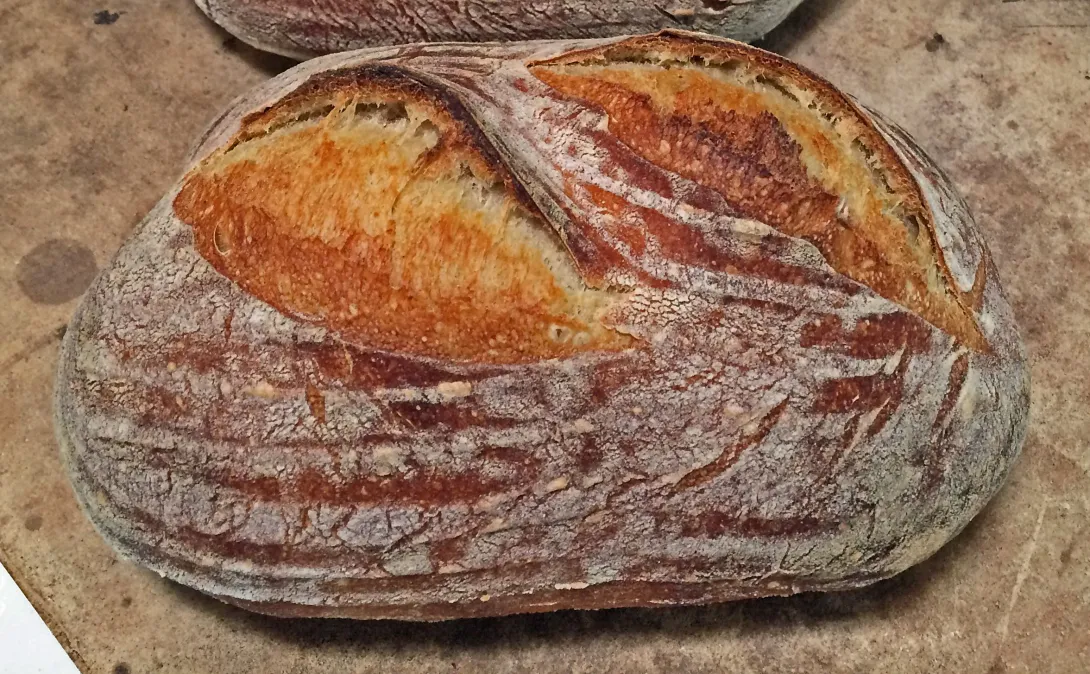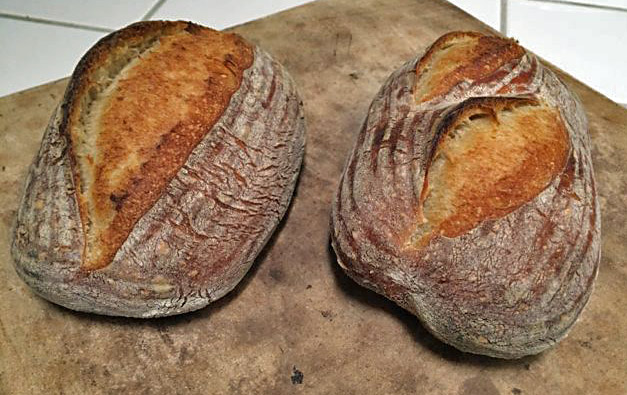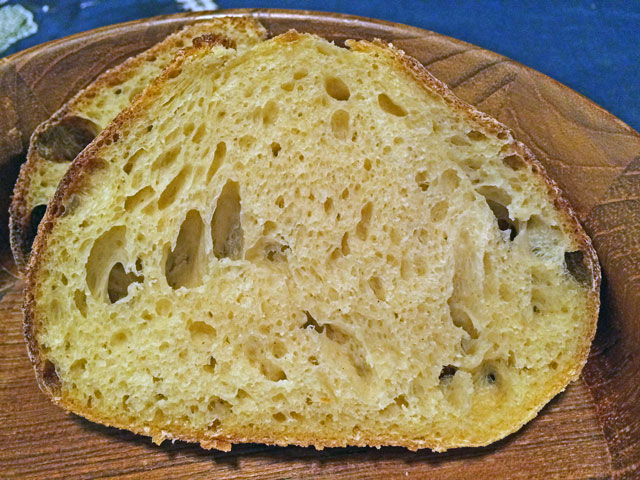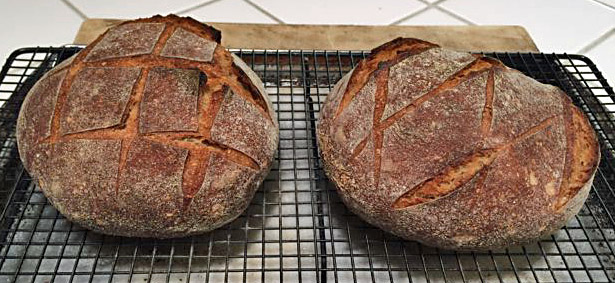
A relatively new TFL member recently asked how to make a sourdough bread. His description of the desired characteristics brought to mind a bread we made in the San Francisco Baking Institute Artisan II Workshop on sourdough baking. It was a decidedly French-style pain au levain with minimal acidic acid tanginess but a creamy, sweet complex flavor. It was the preferred bread of the SFBI faculty. The special features of this white bread were a liquid levain fed every 12 hours that made up about 30% of the total flour in the final dough.
My bake differed slightly from the original, but I give the SFBI formula as it was given to us.
Total Dough Formula | Baker's % | Wt (g) |
AP flour | 99.2 | 641 |
Rye flour | 0.8 | 5 |
Water | 68 | 438 |
Instant yeast (optional) | 0.1 | 0.5 |
Salt | 2.1 | 13 |
Total | 170.4 | 1097.5 |
Levain | Baker's % | Wt (g) |
AP flour | 95 | 102 |
Rye flour | 5 | 5 |
Water | 100 | 108 |
Liquid starter | 40 | 43 |
Total | 240 | 258 |
Note: for the starter feedings, including the levain mix, I actually used my usual starter feeding mix of 70% AP, 20% WW and 10% Rye. So, in the levain, rather than the AP and Rye specified in the SFBI formula, I used 107 g of the above mix.
Mix ingredients thoroughly.
Ferment 12 hours at room temperature. (Note: Because of my own scheduling needs, I refrigerated the levain overnight before mixing the final dough. This was not the procedure at the SFBI, and it would be expected to make the bread somewhat more sour. If you can, omit this levain retardation.)
Final Dough | Baker's % | Wt (g) |
AP flour | 100 | 517 |
Water | 60 | 310 |
Instant yeast (optional) | 0.1 | 0.06 |
Liquid starter | 50 | 259 |
Salt | 2.5 | 13 |
Total | 212.6 | 1099.06 |
Procedures
- In the bowl of a stand mixer with the paddle attachment, pour in the water, add the liquid starter and mix to dissolve the starter.
Add the flour and mix to a shaggy mass.
Let rest, covered, for 20-60 minutes.
Add the salt (and yeast, if you are using it) and mix with the dough hook at Speed 2 for 5-6 minutes. Adjust flour or water to achieve a medium consistency. (Note: I did not use added instant yeast.)
Ferment for 2-3 hours at 76ºF with 1 or 2 folds, as needed to strengthen the dough. (Note: The fermentation time depends on whether you use the instant yeast and on your fermentation temperature. As usual, “Watch the dough, not the clock.” The dough should end up expanded by 25-50% and should be light and gassy. If you ferment in a transparent container, your should see the dough to be well-populated with tiny bubbles.)
Divide the dough into two equal pieces and pre-shape as boules or cylinders.
Let the pieces rest, covered, for 25-30 minutes.
Shape as boules or bâtards.
Proof for 90-120 minutes at 80ºF. (I had a class to teach, so I refrigerated the loaves for 3 hours, then proofed for 2 hours at 80dF)
Bake at 460ºF with steam for 25 minutes. ( I baked at 460dF with steam for 12 minutes, then another 16 minutes at 435dF convection bake in a dry oven.)
Leave in the turned-off oven with the door ajar for another 10 minutes. (Optional)
Cool thoroughly on a rack before slicing.


I also baked a couple loaves of a Pain de Campagne. It is based on the one in FWSY, except I leave out the instant yeast and boost the whole grain flours a bunch. For today's bake, I halved the recipe in the book to make 1100g of dough and divided that into two. We are traveling next week, and I wanted to take a small loaf along for breakfasts and picnics.

Happy baking!
David
- dmsnyder's Blog
- Log in or register to post comments
Nice as always, David.
David
So a bigger levain amount and shorter rise times at warm temperatures will make a less sour bread?
Well, I can say that a shorter fermentation, in general, leads to less sour bread. I don't think the other statements are true as generalizations. There are multiple variables which interact in complex ways.
What one can say is that a particular set of conditions has a particular result. If you change any one of the critical conditions, the result changes.
This can get confusing (from personal experience)!
David
Love the crust and crumb on this one. Well done and happy baking I can usually figure out your spreadsheets but these are beyond my figuring - no worries.
Happy baking David
There are some minor discrepancies in the tables due to rounding. Is there something else you find confusing? I have been known to make calculation errors, typos and other deviations from reality.
I'm glad you mentioned "white bread," because that gives me the opportunity to point out the yellow color of the crumb. This is the true color, not an artifact of lighting or my camera. That's the color of "white" flour that is unbleached and has not been harshly mixed. The yellow is carotenoid pigment that, supposedly, contributes significantly to the flavor of bread. Intensive mechanical mixing oxidizes these chemicals and decreases the flavor complexity of the resulting bread.
David
100% flour and the levain alone does add up to 100% flour when it is much less than the total flour. Just a weird way to do it I guess.
Flour in seed starter: 21g
Flour added to make Levain: 107g
Flour added to make final dough: 517g
21 + 107 + 517 = 645g = Total flour. (Yeah. There was some rounding to whole grams along the way.)
Did I miss something?
David
AP flour 95% 641g and rye flour .83% 5 g which totals 646 G but the % only adds up to 95.83% and it should be 100%. The AP should be 99.17% ?
David
It's so nice to demonstrate that you can have a lovely, creamy open crumb with 68% hydration! I think I've given up on pursuing the high hydration doughs - not enough added benefit from all that extra irritation!
Was it still a nice, tasty bread, even without any overnight retardation? Same-day breads do have a certain attraction, schedule-wise.
68% hydration? How about 65% hydration?
Proth5's 65% hydration baguettes
Here's the formula: Pat's (proth5) Baguettes
Back to my SFBI SD: The bread is very tasty, but it has the mildly sweet, wheaty flavor of a (mostly) white bread. More whole grain flour and longer cold retardation would have resulted in a tangier, more acetic acid flavor. That isn't what this particular bread is about.
David
Interesting explanation about the yellow crumb, before i got to that comment i was trying to figure out what in the ingredients made it yellow!
Anyway, very good looking loaf! Love the golden crust.
Can't wait to see your next bake :)
I'm getting ready to upload a photo of the other bake of the week.
David
Always nice to see your bakes. I am trying to pack for our move and each bag of flour and pot and banneton gets a sigh from my husband as the back of our tiny car fills up and up LOL ! Sorry I gave my truck away to elder son ! I am thinking of removing clothes and leaving the baking stuff...one has to have what is important ...right ???
Happy baking as Dab says...we will be in California come Sept. middle son is in Bishop this week hiking and mt biking..he may never leave he loves it SO much . c
Bishop!? Isn't that .... a bit .... warm in July? I guess we are softies (certainly relative to you!), and we spend as much of July as possible in the Monterey or SF Bay area. We do prefer 60 to 106 dF.
I guess you don't need a lot of clothes for biking and such, but you can't bake bread without flour! It couldn't be clearer.
David
the Minaret vista to see the sunset and the Buck Moon tonight. He said it is 75 and wonderful ! He was at 10,000 feet yesterday on his hike so he is enjoying the cool temps. It is hot here in the South but unfortunately it will be even hotter later in the week and next week all along the East..sigh. Summer is what it is these days. Looking forward to more of your great pics.
You will have to take a look at the pumpkin bread I posted. It is amazing. c
If I haven't said it already, if your next year's travels take you through our neighborhood, I hope you will stop and visit!
David
We have had so many changes in the past month. We are now moving to Lexington VA for one year to be near our son and his family...our only grandchild ! Instead of a cycling trip we are heading West by car for all of Sept to camp and cycle as we go and try to see as much as we can in 1 month. We will be in Eugene OR to see our middle son as he is taking a 10 week job there at the local hospital. We love OR and want to cycle some there. As to where else I know we are going to get to Lassen Natl Park and want to see the Great Basin in NV and some of southern UT . We have the month of Aug. to plan a route . Would be wonderful if we could get as far South in CA as your area. What a sweet invitation and thank you and I will certainly message you if we do get close. c
Your bakes are inspiring, and most of us can only hope to approach your skills. Thanks for sharing.
for your kind words, but you all can do this, if you really want to. The not very secret is study and practice. Not very different from any of the skills I have worked to develop.
David
David,
THANK YOU for taking the time to bake that! Especially for adding in the mixing details. You and everyone else on TFL couldn't be kinder in sharing your passion. That you went so far as to upload pictures is beyond generous!
I baked that yesterday and cut into it moments ago. I wish I had a band saw. I divided my dough into two parts and baked 15 minutes in Dutch oven at 450°F and then 400°F uncovered on convection. I couldn't get a nice brown crust before internal temps hit 212° for one and on the second, separate bake, it hit 207°F.
My crust was blistered but pale. It wanted to be crispy but softened and toughened. The crumb was tight and chewy marked with caverns that would have preferred being delicate holes. I was happy to finally see some ears from my scoring, however.
I took pictures and think I'll post an entry recommending this recipe for Beginner II bakers as it introduces baker's percentages, charts, a levain, a flour mixture, along with times to be on the lookout for something significant to happen. Dividing it in two let's you experiment with proofing times.
I think I'm overhandling my dough. I'm convinced that I'm forming my boules too tightly, now that I think of it. I'm really rounding it up and compressing the dough, squeezing the breath of life out of it. I use my bench scraper to plow and twist the dough and then round it up some more with my hands. My next bake will form just enough to stretch a membrane and STOP!
I also think it might be hard to get that bold carmel color on the crust with a 500g dough - at least for me. :)
Such a wonderful loaf you baked there, David. Again, that you took the time to show how it's done was a gift. Thank you, sir, for being part of this community.
As an aside, now and again, I'll search for a "how to" on The Google and will come across another community. Nothing compares to the depth, breadth, and activity found right here. New folks like me are welcomed even by veterans of baking of 20-30 years. Amazing! Thank you all!
Murph
I think you are on the right track.
You should not be pressing down on the dough. You should be stretching it over itself. The only squeezing or mashing is when you seal the seams, and there are even better ways of doing that.
Some have found this little pictorial tutorial helpful: Shaping a boule: a tutorial in pictures.
Also, view Hamelman's instructional video on loaf shaping. Techniques for the Professional Baker - 4 - Shaping
David
Great oven spring, crust and open crumb. Since baking Hamelman's Pain au Levains I'm somewhat enamored by P au L.
I think I need to find a new AP bread to bake as baguettes. Hmm. What to do, what to do, what to do...
alan
I'm thinking you will somehow figure out "what to do."
This bread is very similar to Hamelman's, which is interesting in that this uses a liquid levain and JH's uses a firm levain.
David
Looks wonderful! This is your electronic bread "starter." Others will use it to make bread in their kitchen. I like that idea very much.